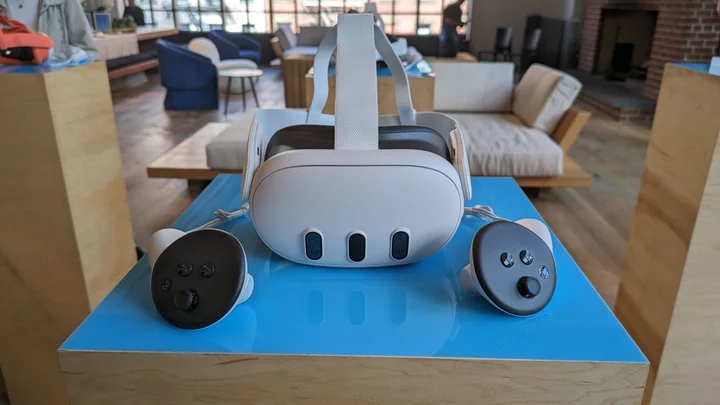Meta's quest to deliver high quality, untethered VR experiences at somewhat affordable prices might be nearing its end.
Not because the company is going to stop producing headsets or anything like that, of course. I say that because I got to try the new Meta Quest 3 headset during a relatively short press event a couple of weeks ago and it's easily the most impressed I've been by Meta's hardware efforts to this point. Even bearing in mind that the demo space was manicured about as ideally as possible for VR usage, there's so much about the Quest 3 that just works in a way VR hasn't up to this point.
And honestly, the most impressive thing about the Quest 3 is how it enables you to get out of VR without taking off the headset. Let's dig in.
SEE ALSO: Meta Verified for business will cost $965 less per month than X's business verificationJust passing through
They still haven't invented a VR headset that won't mess up your hair. Credit: MetaAt first glance, the Quest 3 immediately stands out from its 2019 predecessor with a slimmer overall profile and a whole mess of camera lenses on the front of the headset. We'll get into what those do in a bit, but first, here are some basic specs you need to know:
Two LCD displays at 2064x2208 resolution with 90Hz refresh rates
Snapdragon XR2 Gen 2 processor
8GB RAM
128GB or 512GB storage
Two RGB cameras with a depth sensor for full-color passthrough
2-3 hours of battery life, the same as Quest 2
Without dancing around it any longer, the onboard cameras that provide full-color passthrough (or the ability to see the world around you in full color while wearing the headset) are as close to a game-changer as anything else on the Quest 3. On Quest 2, the passthrough feature produced a fairly ugly black-and-white image that was only useful for drawing a play area in your room. It wasn't something with any real AR potential and certainly wasn't something you wanted to use any more than you had to use it.
But with Quest 3, you can comfortably navigate around a room and even have a conversation with someone while wearing the headset. It's as easy as double-tapping the right side of the headset, which switches the passthrough on and off at any time. This is all thanks to the aforementioned cameras that are able to digitally recreate the space around you with pretty impressive sharpness and clarity. A nice bonus is that scanning the play area has been drastically simplified and improved; instead of manually drawing a boundary around yourself, you can now just look around the room and the Quest 3 automatically scans the play space and even detects furniture for you.
I want to stop for a second and mention a major caveat, which is that the demo space I used was manicured perfectly for the Quest 3. The furniture was sparsely spread out in a way it wouldn't be in my tiny Brooklyn apartment. I have no way of knowing how well the Quest 3's room scanning works in more cluttered environments. I can only say that, in the limited demo I was given, it worked extremely smoothly.
'BAM!' is as light as games get, but it showed off the passthrough well. Credit: MetaAs for how this effects authored VR/AR experiences like video games, I only got a minor taste of that but came away feeling positively about it. One AR demo was a simple multiplayer game called BAM! where another participant and I controlled tiny little robots on a floating arena that appeared in the room in front of us. We could use the Quest 3's controllers (which are very similar to the Quest 2's, minus the weird ring around the hands) to resize the arena in real-time, and thanks to passthrough, I could see everything that was happening around me while playing a game in a dang headset.
I also got to try a more impressive single-player demo called First Encounters, which involved shooting cute little aliens with dual laser pistols as they swarmed the room around me. The aliens would hide behind furniture and I could detect them with the Quest 3's built-in spatial audio while also chatting with the demo attendant, which is cool. If I shot the virtual "walls" around me, they would break apart and the real demo space around me would creep through into the game world.
AR is obviously not new at all, but the new passthrough features on Quest 3 allow for really neat experiences that the Quest 2 just couldn't do. My only concern is that the things I saw were brief little tech demos that are cool precisely once. Meta's long-term challenge with Quest headsets has been giving folks like me a reason to keep putting the headset on after the initial novelty wears off. Maybe the Quest 3 can provide that reason with its new AR features, but I'll need to see more substantial use cases first.
The actual VR part is fine, too
It's a big jump, technically speaking. Credit: MetaWhen it came to non-passthrough VR experiences, the Quest 3 again performed admirably in limited demo sessions, but didn't offer much in the way of huge innovation.
The main things to know are that the Quest 3's lenses are much higher resolution than the Quest 2, and the processor inside the headset is a lot more powerful, too. Everything looks so much sharper and nicer than it did in the older headset, and side-by-side game comparisons Meta showed me included a substantially higher level of detail and texture quality in Quest 3 versions of games. It isn't quite PS5 level, but it's a lot better than before.
Meta also updated the Touch controllers (they're called Touch Plus now), removing the strange ring-like enclosure that aesthetically defined the previous model. As far as I could tell, the button layout hasn't been appreciably changed at all. The biggest change is new haptic sensors in both controllers that allow for fun, rumbly sensations when you do things like pull back the drawstring on a bow.
The controller is a lot more normal-looking this time around. Credit: Alex Perry/MashableSony's DualSense controller for PS5 is still the standard-bearer for immersive gaming haptics in my book, and the inclusion of a similar feature in Quest 3 is definitely something I will not complain about.
My brief time with the Quest 3 certainly left me feeling confident that the final product will (at the very least) be better than Quest 2, but there are a couple areas of concern. The first one is price; the 128GB model runs for $500 and the 512GB model for $650. That's significantly more than the Quest 2's $300 launch price. Meta's myriad improvements to the hardware arguably justify the price hike, but the Quest 2 might still be a better value for those who are more casually curious about VR.
My other big qualm with Quest 3 is the battery life, which I was told by Meta personnel is pretty much the same as Quest 2. That means you'll get roughly two or three hours of use depending on what you're doing before it has to charge again. Such is the cost of doing business when it comes to untethered VR, I suppose.
But taken as a whole, Meta has clearly identified some key weaknesses of the Quest 2 and turned them into strengths with Quest 3. It may not kickstart a VR revolution, but it'll make a way better impression for first-timers than the Quest 2 did, if nothing else.









